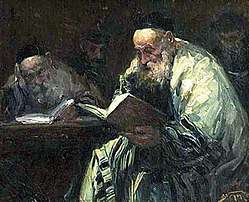Yalkut haMachiri
Yalkut haMachiri (Hebrew: ילקוט המכירי) is a work of midrash. Its author was Machir ben Abba Mari, but not even his country or the period in which he lived are definitively known. Moritz Steinschneider[1] supposes that Machir lived in Provence; but the question of his date remains a subject of discussion among modern scholars. Strack & Stemberger (1991) indicate that the work was most probably composed in the late 13th or 14th century.
| Rabbinic literature | ||||||||||||
|---|---|---|---|---|---|---|---|---|---|---|---|---|
 Talmud Readers by Adolf Behrman | ||||||||||||
| Talmudic literature | ||||||||||||
|
||||||||||||
| Halakhic Midrash | ||||||||||||
|
||||||||||||
| Aggadic Midrash | ||||||||||||
|
||||||||||||
| Targum | ||||||||||||
|
||||||||||||
Contents
Yalkut haMachiri is similar in its contents to Yalkut Shimoni, with the difference that while the latter covers the whole Bible, haMachiri covers only the books of Isaiah, Jeremiah, Ezekiel, the twelve Minor Prophets, Psalms, Proverbs, and Job.
In the introductions, apparently very similar, to these books, Machir gave his motivation in composing the work: to gather the scattered aggadic teachings into one group. He seems to have thought it unnecessary to do the same thing for the Pentateuch and the Five Scrolls, as it had been done already (to a certain extent) in Midrash Rabbah; but it may be concluded that Machir intended to make such a compilation on the earlier prophetical books as well. From his introduction to the part on Isaiah, it would seem that he began with Psalms and finished with Isaiah, though in his introduction to the part on the Psalms he mentions the other parts.
Sources
Machir used the following sources in his compilation: the two Talmuds, the Tosefta, the minor treatises, the Sifra, the Sifre, Pesikta Rabbati, Midrash Rabbah on the Pentateuch, Midrash Ḳohelet, Midrash Tehillim, Midrash Mishle, Midrash Iyyob, Midrash Tanhuma, a Midrash quoted as דשחנו"ע, Pirkei de-Rabbi Eliezer, Seder Olam Rabbah, and Haggadat Shir ha-Shirim, frequently quoting the last-named Midrash in the part on Book of Isaiah. Machir had another version of Deuteronomy Rabbah, of which only the part on the section "Devarim" exists now.[2] It is difficult to ascertain whether Machir knew of Midrash Yelammedenu; he quotes only Midrash Tanhuma, but the passages which he cites are not found in the present text of that work, so that it is possible that he took these passages from the Yelammedenu.
Only the following parts of the Yalḳuṭ ha-Makiri are extant: Isaiah, published by I. Spira[3] from a Leyden manuscript; Psalms, published by S. Buber (Berdychev, 1899) from two manuscripts (one, previously in the possession of Joseph b. Solomon of Vyazhin, was used by David Luria, and its introduction was published by M. Straschun in Fuenn's Ḳiryah Ne'emanah, p. 304; the other is MS. No. 167 in the Bodleian Library); the twelve Minor Prophets;[4] Proverbs, extant in a manuscript which is in the possession of Grünhut,[5] and which was seen by Azulai,[6] published by Grünhut in Jerusalem in 5662 (= 1902).
Significance
Moses Gaster[7] attached great importance to Yalkut haMachiri, thinking that it was older than Yalkut Shimoni, the second part of which at least Gaster concluded was a bad adaptation from Yalkut haMachiri. Gaster's conclusions, however, were contested by A. Epstein,[8] who declares that Yalkut haMachiri is both inferior to and later than "Yalkut Shimoni." Buber conclusively proved[9] that the two works are independent of each other, that Machir lived later than the author of the "Yalkut Shimoni," and that he had not seen Yalkut Shimoni. Samuel Poznanski thinks that Machir lived in the fourteenth century.
References
- Jewish Literature, p. 143
- Compare S. Buber, Liḳḳutim mi-Midrash Eleh ha-Debarim Zuṭa, Introduction
- Berlin, 1894; compare Israel Lévi in R. E. J. xxviii. 300
- British Museum, Harleian MSS., No. 5704, for which compare A.W. Greenup, The Yalkut of R. Machir bar Abba Mari / ed., for the first time, from the unique MS. (Harley, 5704) in the British Museum, London 1909-1913 (3 vols.)
- Zeit. für Hebr. Bibl. 1900, p. 41
- Shem ha-Gedolim, ii., s.v. "Yalḳuṭ ha-Makiri"
- Revue des études juives xxv. 43 et seq.
- "R. E. J." xxvi. 75 et seq.
- In the introduction to his edition of "Yalkut haMachiri"

- The JE cites Poznanski, in R. E. J. xl. 282 et seq., and the sources mentioned above.
- Strack, H.L.; Stemberger, G. (1991), Introduction to the Talmud and Midrash, Edinburgh: T&T Clark, ISBN 978-0-8006-2524-5.